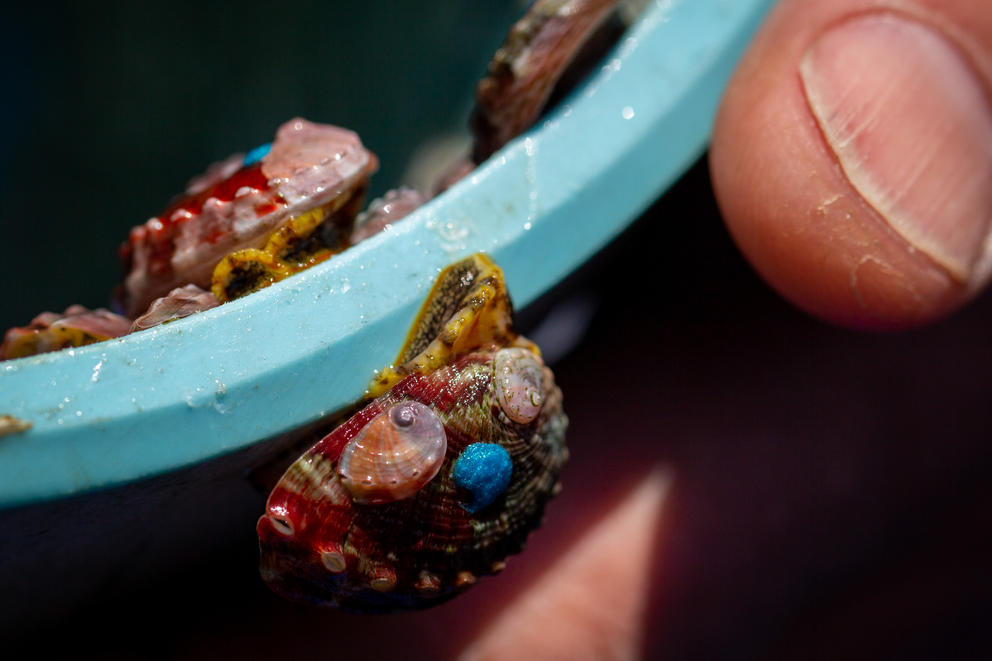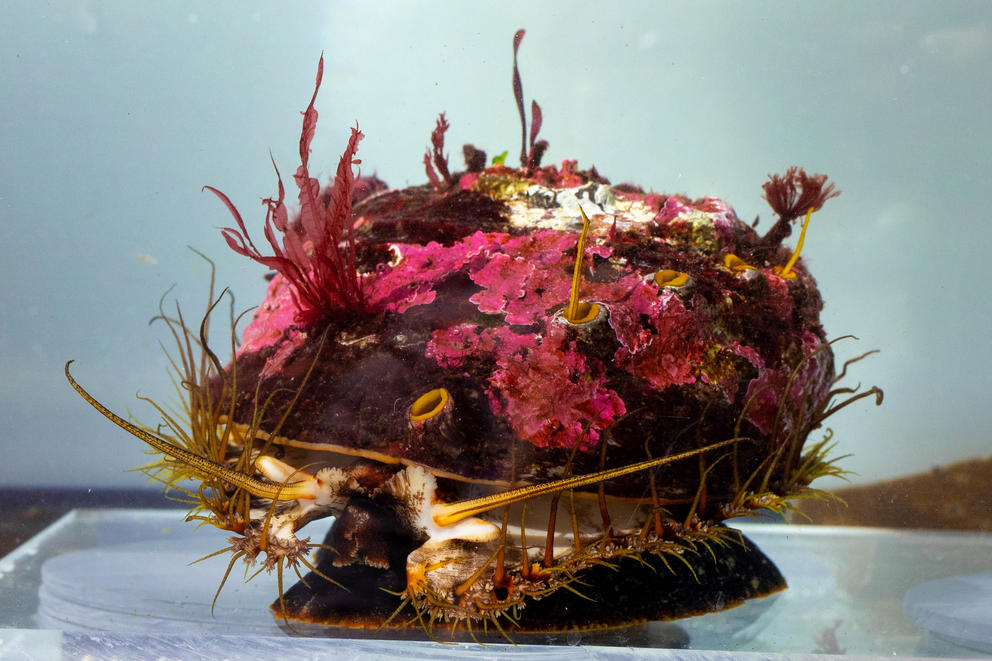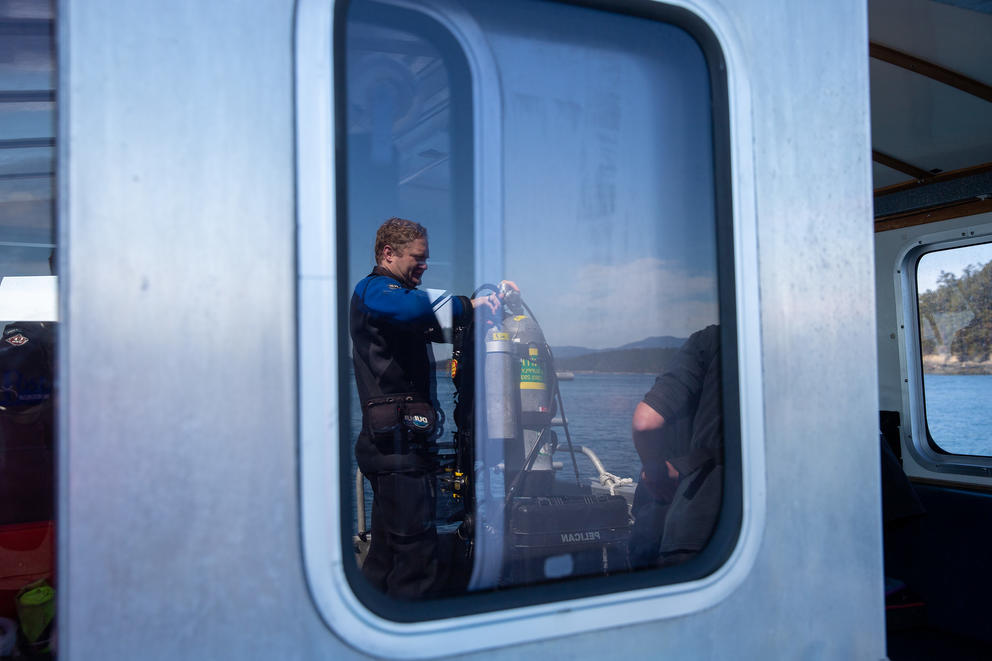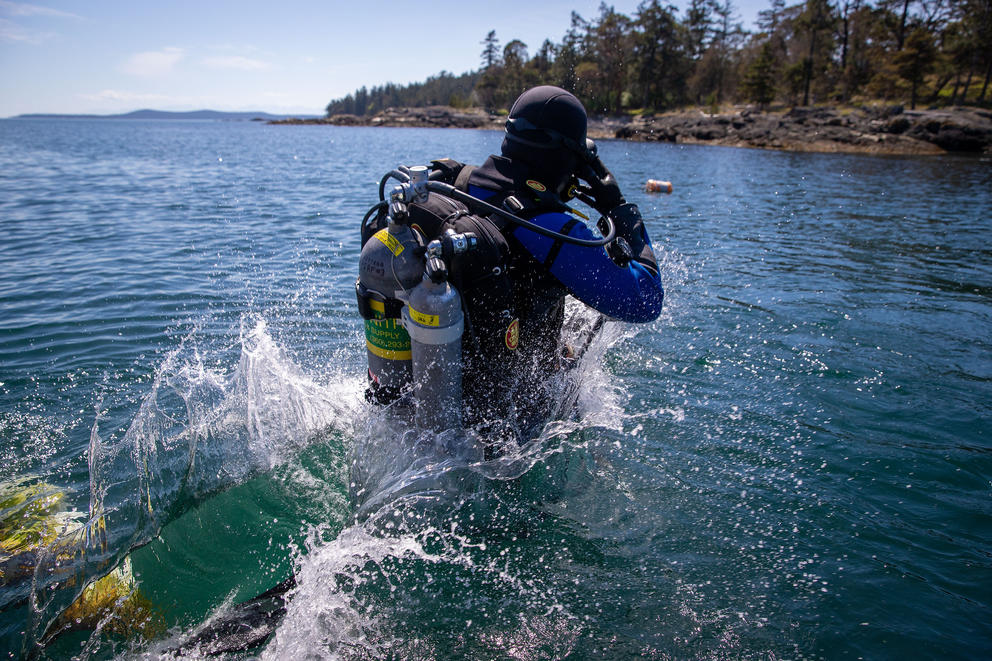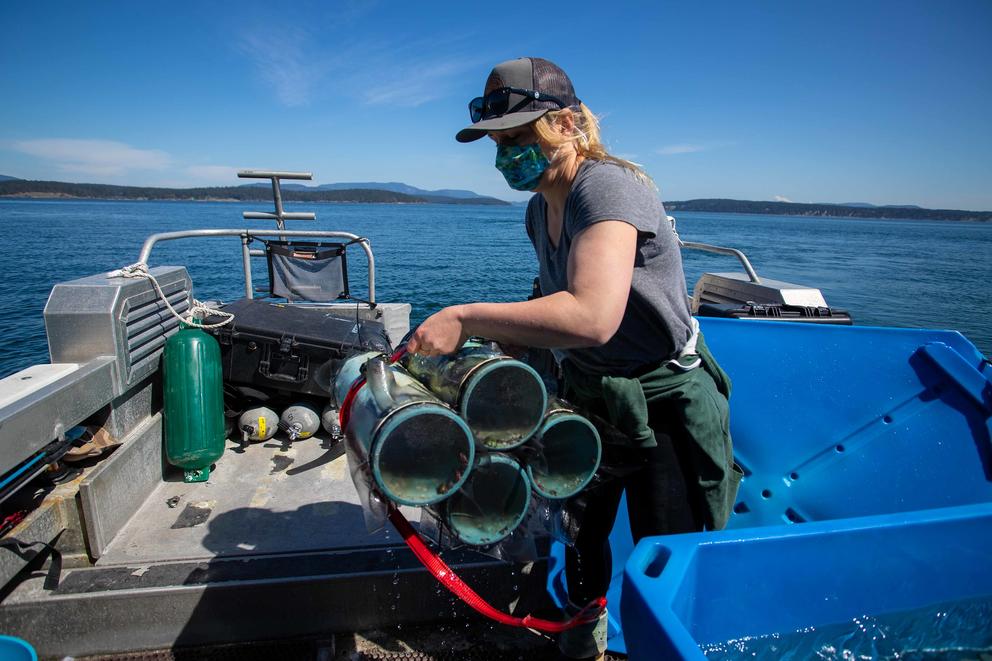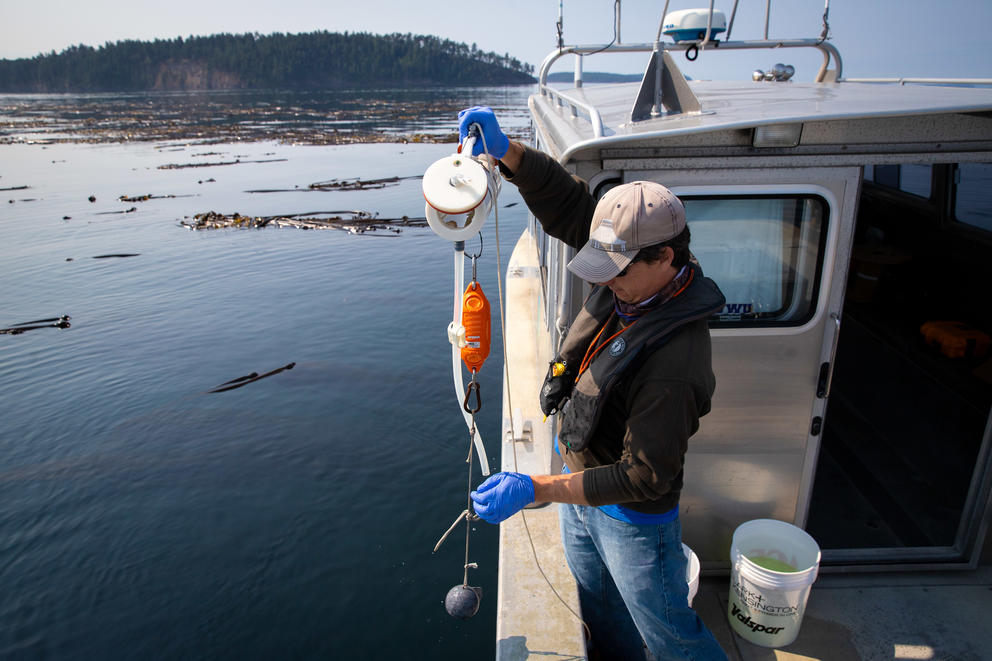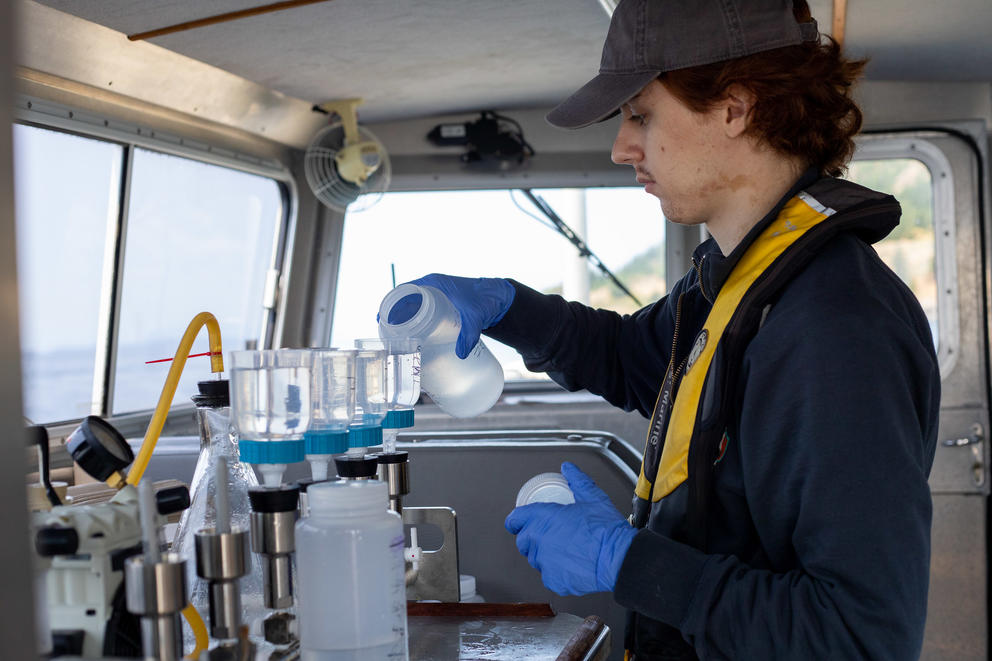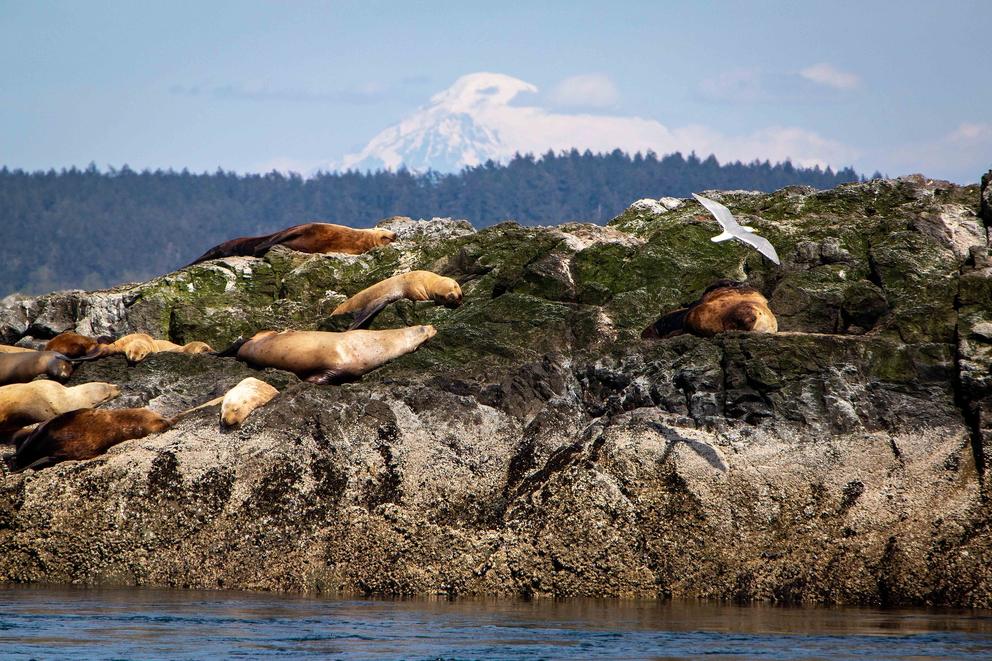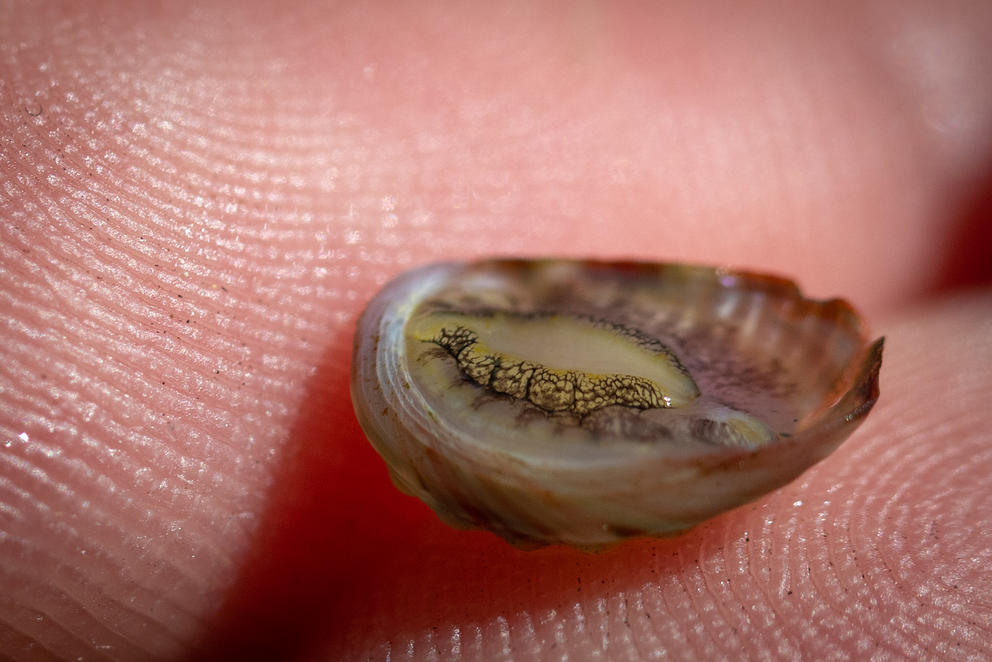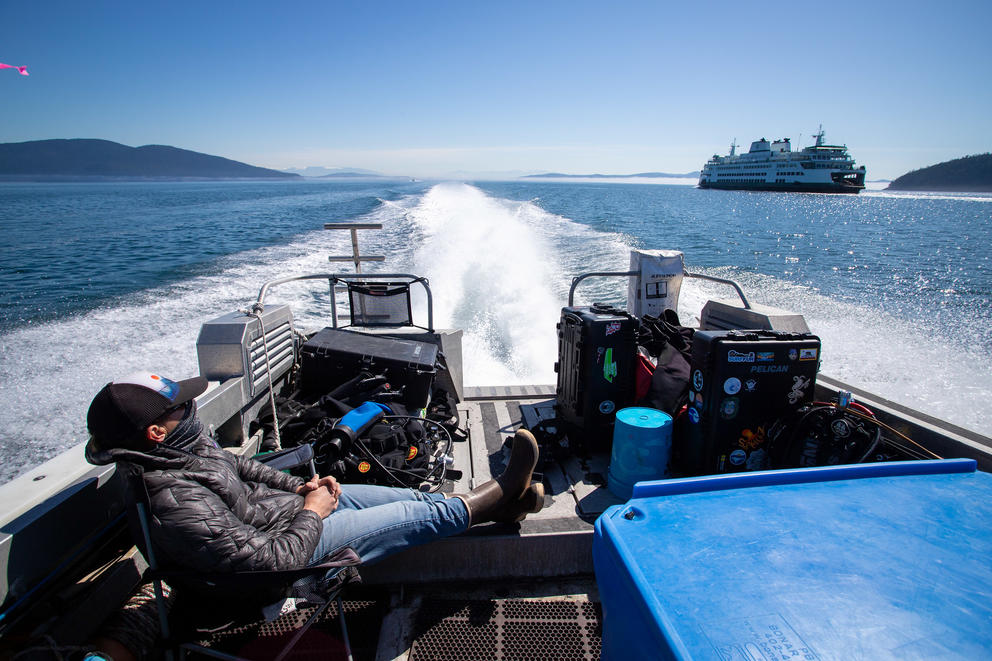This adult pinto abalone shows off its underwater elegance and flare as its hundreds of epipodial tentacles explore its surroundings. The mix of coralline algae, red algae and a feather duster worm atop its shell all help indicate just how easily this animal blends into'its natural surroundings. This individual, scientifically known as GR29, is a male harvested from the wild in April 2021 as broodstock, though he wasn’t quite up to the challenge this breeding season. Kept at the Kenneth K. Chew Center for Shellfish Research at the National Oceanic and Atmospheric Administration’s Manchester Research Station on the Kitsap Peninsula, he is one of 40 adult abalone that form the breeding program, all of which have been collected since 2015. (Gemina Garland-Lewis for Crosscut)
Found from Baja California, Mexico, to southeast Alaska, pinto abalone are the widest-ranging species of their kind on the Pacific coast of North America. And they are the only abalone found in Washington waters. The pinto was plentiful here until appreciation for their delicacy took its toll.
A drastic decrease in their numbers led to a total ban on harvesting in 1994, which was likely too little, too late. Instead of recovering, Washington’s pinto abalone population continued to plummet and is now considered functionally extinct. In 2009, the pinto abalone was listed as a state endangered species after advocacy by researchers from the Washington Department of Fish and Wildlife. It was the first time a marine invertebrate was listed at the state level, raising not only awareness, but also opening avenues for funding a recovery program. The focus had shifted from fisheries management to saving the species altogether.
Although the use of environmental DNA, or eDNA, has proved a successful method of measuring other rare or threatened species, this is the first time it has been tried with pinto abalone. Here, Dr. James Dimond drops a Niskin bottle among the waving stands of a bull kelp forest. With two stoppers at either end that can be closed at a desired depth, this instrument allows the research team to collect water from the same part of the water column that they most expect pinto abalone to be found, which is around 5 to 10 meters in the San Juan Islands. This increases the likelihood that the researchers will find the evidence of abalone through the eDNA they’re looking for. (Gemina Garland-Lewis for Crosscut)
When it become clear that leaving pintos alone was not going to save them, scientists, government officials and tribal groups came together to step in more actively, building a conservation aquaculture program to rear young abalone in a National Oceanic and Atmospheric Administration hatchery facility and then release them into their natural habitat when they are a year or two old. This approach to the snail’s recovery has proceeded on a parallel path with dive surveys throughout the San Juan Archipelago by the state Department of Fish and Wildlife and the Puget Sound Restoration Fund.
Dr. Hank Carson of the Washington Department of Fish and Wildlife suits up for a dive in the San Juan Islands. As recovery efforts continue and more and more juvenile abalone are released into the wild, the frequency and spatial scope of population monitoring are expected to increase. (Gemina Garland-Lewis for Crosscut)
Dr. Hank Carson, lead abalone scientist at the Washington Department of Fish and Wildlife, leaps off a research vessel in the San Juan Islands to start an outplant dive. He and team members will place 2,000 to 3,000 juvenile abalone raised in the hatchery at each site they will visit today as part of ongoing restoration efforts. (Gemina Garland-Lewis for Crosscut)
These dives provide not only opportunities to discover existing wild abalone and monitor the success of juvenile abalone “outplants,” but also enable scientists to collect broodstock to help maintain genetic diversity among the next generations the team is releasing. Since 2009, more than 40,000 juvenile abalone have been released at 21 sites in the San Juan Archipelago. As the project grows, more hatchery facilities have been added, including one at the Seattle Aquarium that helps to engage the wider community in the recovery effort.
Dr. Katie Sowul of the Washington Department of Fish and Wildlife hoists PVC tubes holding thousands of lab-reared juvenile abalone from a saltwater tank on board the team’s research vessel. A few more steps and the abalone will be passed off to one of her dive colleagues in the water, who will set them free into their natural environment. It's an exciting day for team members, who have looked forward to this moment for a year or more. During one week in April 2021, her team outplanted about 10,000 of these baby snails into sites around the San Juan Islands. The work is part of a collaborative effort including the Department of Fish and Wildlife, Puget Sound Restoration Fund, the National Oceanic and Atmospheric Administration, the Jamestown S’Klallam Tribe and others. Cumulatively, over 40,000 hatchery-raised juvenile abalone have been outplanted at 21 sites in the San Juan Archipelago. (Gemina Garland-Lewis for Crosscut)
Dimond, a marine biologist at Western Washington University who focuses on genomic approaches to ecology and conservation, wanted to see if the recovery project could be aided by the use of environmental DNA, or eDNA.
“I've been fascinated by the idea that we can use DNA floating around in the water column to help us locate species that are hard to find, or estimate the biodiversity of an ecosystem,” said Dimond, whose research on this project was funded by the SeaDoc Society.
To decide which new sites to sample and test for the presence of abalone eDNA, the presence of healthy-looking kelp beds is a must. Thanks to an abundance of high-quality aerial imagery available to researchers, including Google Maps satellite view and the shoreline photos in the Washington Coastal Atlas, Dr. James Dimond's team can use aerial imagery to determine their sample sites before even stepping foot on a boat. (Gemina Garland-Lewis for Crosscut)
Although the data that dive teams can gather from direct observation is rich, they have their limits. Because of the abalone’s preference for tucking away in nooks and crannies among the rocks (with shell camouflage to boot), it’s estimated that only 20% to 40% of the abalone present are noted by the dive team. Diving for data requires a large team and is also quite expensive, causing concern that traditional methods alone won’t be efficient or sufficient for saving the Washington abalone.
During the past decade, research using eDNA — DNA from an organism found in the environment, such as from sloughed skin, feces, larvae, etc. — has shown particular promise when it comes to detecting rare or endangered species. To ensure the eDNA method was going to work, Dimond took water samples from abalone tanks at the hatchery facility at NOAA’s Manchester Research Station. This first step allowed him not only to make sure that he was finding abalone eDNA in the water, but also to better quantify before going out into the field how many individuals a given DNA signal related to.
Dr. Jay Dimond gets ready to drop a Niskin bottle off the side of the reseaarch team’s boat to collect water samples for his eDNA research. The weight at the bottom helps the team collect water at the 15- to 35-foot depth range they're looking for, which is based on the abalone's preferred habitat. This provides the greatest chance they'll pick up a signal of what they're hoping to find. (Gemina Garland-Lewis for Crosscut)
Ryder Gathright, a rising junior at Seattle University at the time of this photo, pours water samples into vacuum filters on board the Zoea, a research vessel at Shannon Point Marine Center. He worked with Dimond as a research assistant on the pinto abalone project. Once all the water has been run through, the small filter is folded and saved for eDNA testing back in the lab. (Gemina Garland-Lewis for Crosscut)
Then he and the dive teams took water samples from areas with a known abalone presence, but in their real-world environment. Here, Dimond found that, while the concentration of abalone eDNA was lower than measured in abalone holding tanks at the hatchery, it was still positively associated with abalone biomass at each site.
Eighty water samples were collected by Dimond and Gathright, his undergraduate research assistant, without the dive team to see how their methods worked while exploring new areas. Most of the sites the pair sampled were chosen with the help of aerial imagery, scouting for what looked like good abalone habitat, but where the actual presence of the animal was unknown.
Although seven different abalone species are found along the West Coast of the U.S., here in the Salish Sea there is only one — the pinto abalone. This abalone makes its home in rocky areas with kelp beds along well-exposed coasts. As the only abalone species and the only sizable marine snail in this region, the success or loss of its population has far-reaching impacts. (Gemina Garland-Lewis for Crosscut)
Collecting a water sample for eDNA analysis is a relatively straightforward and efficient process, especially when compared with a dive survey.
Dimond stops the engine in a thick kelp bed nestled next to rocky reef habitat, just where the abalone themselves like to be. To increase the odds of finding eDNA, water samples are taken from the depth that the snails actually live at, about 15 to 35 feet. In order to accomplish this without getting in the water themselves or diluting their sample with water from a different depth, the team uses something called a Niskin bottle — essentially a water bottle with trap doors on either end. The special bottle allows them to collect at whatever depth they choose.
Once the bottle is back on board the boat, Gathright pours the water through a vacuum filter, leaving only the small bits and pieces of greenish-brown fuzz that hide the invisible clues to what lives below. Back in the lab, DNA extraction and quantitative PCR provide the final answers.
Morgan Adkisson of the Puget Sound Restoration Fund is responsible for day-to-day care and husbandry of the adult and juvenile abalone in hatchery facilities. Here, she climbs down from feeding the young abalone that are part of a new breeding program with the Seattle Aquarium. (Gemina Garland-Lewis for Crosscut)
Just from their preliminary work a new site has been discovered for placing the juvenile snails, and some new broodstock have been collected. That’s a promising sign of things to come with more eDNA efforts, which Hank Carson, the Department of Fish and Wildlife’s lead researcher for the abalone recovery program, credits as one reason his team has been able to set up six new restoration sites this year, making it the speediest setup in the project’s history.
The scientists also believe the eDNA technique will help them maintain genetic diversity in their broodstock without having to bring in pinto abalone from other parts of their range, because this approach helps the scientists to discover new areas where abalone are already present.
The Seattle Aquarium got its inaugural batch of juvenile abalone in June 2021 — a total of 9,633 from 18 unique families. In addition, the aquarium received larvae that the Puget Sound Restoration Fund settled in 18 of the aquarium's tanks — a total of 270,000 larvae from nine unique families. These animals are still too small to inventory, so the team isn't sure how many of this cohort there currently are. (Gemina Garland-Lewis for Crosscut)
Thirty of the sites Dimond and Gathright sampled showed some presence of abalone eDNA, and if a particularly high density of abalone were found through this method, this could even lead to new protections, such as a marine reserve.
“This will be even more useful as we expand into the Strait of Juan de Fuca, an area we have explored relatively less for abalone compared to the San Juan Islands,” Carson said. Otherwise, they need to make predictions based on things like whether there is kelp on the surface and aspects of nearby shorelines or the seafloor, often with limited information available. “There is a lot of shoreline that looks good under those criteria, but an eDNA hit really increases the chance of success with dive time.”
Of course, eDNA would not replace traditional methods, but provide important data that could help make restoration efforts more efficient and effective. In addition, the researchers are excited about the possibility that these techniques could also be undertaken by citizen scientists.
Kayakers, for instance, could take water samples that help refine where abalone may be located. Such citizen science work has proved effective with a wide variety of research projects worldwide, not only increasing the capacity to collect data but, importantly, engaging the community in the process and helping involve those outside of the traditional scientific fields.

